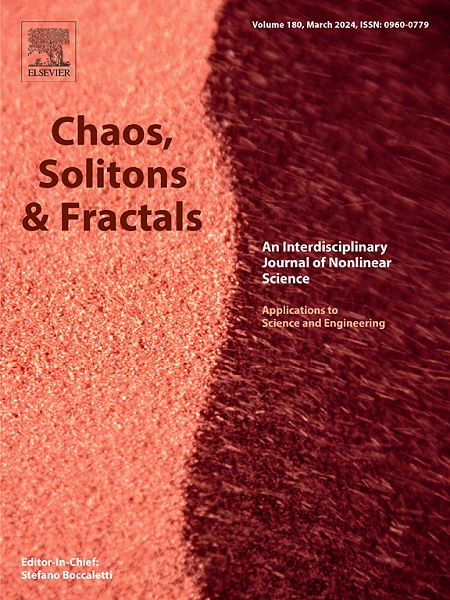Non-autonomous standard nontwist map
IF 5.3
1区 数学
Q1 MATHEMATICS, INTERDISCIPLINARY APPLICATIONS
引用次数: 0
Abstract
Area-preserving nontwist maps locally violate the twist condition, giving rise to shearless curves. Nontwist systems appear in different physical contexts, such as plasma physics, climate physics, classical mechanics, etc. Generic properties of nontwist maps are captured by the standard nontwist map, which depends on a convection parameter and a modulation coefficient . In the spirit of non-autonomous systems, we consider the standard nontwist map (SNM) with a linearly increasing modulation coefficient, and we investigate the evolution of an ensemble of points on the phase space that initially lie on the shearless invariant curve in the initial state, called shearless snapshot torus. Differently from the SNM with constant parameters — where we can see different scenarios of collision/annihilation of periodic orbits leading to global transport, depending on the region in the parameter space — for the SNM with time-dependent parameters, the route to chaos is not only related to the path in the parameter space, but also to the scenario of the evolution of parameter . In this work, we identify power-law relationships between key parameters for the chaotic transition and the iteration time. Additionally, we analyze system reversibility during the chaotic transition and demonstrate an extra transport, where parameter variation modifies the diffusion coefficient.
非自治标准非扭曲映射
保面积非扭转映射局部违反扭转条件,产生无剪切曲线。非扭曲系统出现在不同的物理环境中,如等离子体物理、气候物理、经典力学等。非扭转映射的一般性质由依赖于对流参数a和调制系数b的标准非扭转映射捕获。在非自治系统的精神下,我们考虑具有线性增加调制系数的标准非扭转映射(SNM),我们研究了初始状态下位于无剪切不变曲线上的相空间上的点集合的演化,称为无剪切快照环面。与具有恒定参数的SNM不同——我们可以看到周期轨道的碰撞/湮灭导致全局输运的不同场景,取决于参数空间中的区域——对于具有时间依赖参数的SNM,通往混沌的路径不仅与(a,b)参数空间中的路径有关,而且与参数bn的演化场景有关。在这项工作中,我们确定了混沌过渡的关键参数与迭代时间之间的幂律关系。此外,我们分析了系统在混沌过渡期间的可逆性,并证明了一个额外的输运,其中参数变化改变了扩散系数。
本文章由计算机程序翻译,如有差异,请以英文原文为准。
求助全文
约1分钟内获得全文
求助全文
来源期刊

Chaos Solitons & Fractals
物理-数学跨学科应用
CiteScore
13.20
自引率
10.30%
发文量
1087
审稿时长
9 months
期刊介绍:
Chaos, Solitons & Fractals strives to establish itself as a premier journal in the interdisciplinary realm of Nonlinear Science, Non-equilibrium, and Complex Phenomena. It welcomes submissions covering a broad spectrum of topics within this field, including dynamics, non-equilibrium processes in physics, chemistry, and geophysics, complex matter and networks, mathematical models, computational biology, applications to quantum and mesoscopic phenomena, fluctuations and random processes, self-organization, and social phenomena.
 求助内容:
求助内容: 应助结果提醒方式:
应助结果提醒方式:


